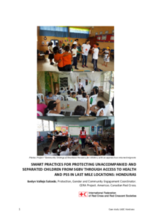OBJECTIVE
The objective of the mission was to gather data on Honduras as a case study to support the IFRC global study on smart practices for protecting unaccompanied and separated children (UASC) from sexual and gender-based violence (SGBV) through health and psychosocial services in last mile locations.
METHODOLOGY
1) Meetings were held: a) virtually with Honduras Red Cross personnel, b) in presence in Tegucigalpa with volunteers and staff of the National Society and other key informants, c) in San Pedro Sula with key informants from the Attention Centers for Returned Migrants (see appendix 1 for a list of key informants interviewed) 2) A literature review was conducted (see appendix 2 for a list of documents)
BACKGROUND
a) How many UASC are present in the country? How many are girls and how many boys? What is the age ranges of the UASC? Where do the UASC originate from? What factors are driving children to become UASC in the country?
In Honduras, in 2015 there were 3091 unaccompanied children returned from abroad, as well as 22 unaccompanied children of foreign origin who were found in an irregular situation in Honduras; according to DINAF for this ear there were returned 8378 children (including accompanied, unaccompanied and separated children) In terms of 20161, according to the information provided b the CANFM Belén and DINAF there were 4 257 unaccompanied children, 6 395 accompanied children, 41 456 adults and 4 467 family groups that were returned The ear of 2016 had the highest rates of returned Honduran children in the last 4 ears For 2017, there were 4823 returned children, with no data available of being accompanied, unaccompanied or separated It is important to mention that DINAF considers only two categories accompanied (including the legal caregivers and other family members) and unaccompanied children The municipalities with most migrant child population were San Pedro Sula and the Central District, followed b La Ceiba These municipalities are ubicated at the departments of Cortés, Francisco Morazán and Yoro. These zones (Francisco Morazán and Cortés) are the main expellers of migrants, and therefore the deported population returns to them In addition, the are the ones with the greatest economic dynamism, which would allow the deportees to enter the labor market and, consequently, safe to return to the United States again (which is the typical goal of the deportees) In the case of Cortés, deportation flows are greater because it is the geographical point where deportees enter, both by air and by land.

